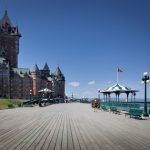In 1966 Toronto, you could smoke in elevators, but men had to doff their hats.
In the early 19th century, when Canada was very much British, you could be hanged if caught singing the pro-United States protest song “Yankee Doodle Dandy,”.
In the now super-trendy and expensive Yorkville section of the city, folk legends like Joni Mitchell and Gordon Lightfoot got their musical start during that neighborhood’s edgy bohemian days.
And that smiling tour guide with the goatee standing next to a cardboard figure of a Canadian Mountie in the historic St. Lawrence Market will be more than happy to tell you about all of that and much more.


“I do this year round and January can be as busy as August,” said Bruce Bell, 55, owner/operator of Bruce Bell Tours in Toronto since 2003. “People love Toronto all year, it really is the New York City of Canada.”
I took Bell’s two-hour plus tour one blisteringly hot summer day ($25 per person, food tasting included), which begins at the St. Lawrence Market where Bell tells tour takers he can be found next to the cardboard Mountie, and found him equal parts historian and showman as he imparted non-stop information in such an enthusiastic, seemingly spontaneous way, you’d swear it was the first time he’d done it.
Over by the Toronto- Dominion Center, a five-and-one-half acre site of towering office buildings, Bell said the city was really built up in the last few decades, starting when Montreal enacted a rule that only French could be spoken when conducting business. Toronto had no such rule and big banks, insurance companies and other big businesses quickly switched headquarters here, he said.
“Montreal was the richest city in Canada,” Bell said, eyes darting up and down the busy street, plotting where we’d go next. “But after that, instantly, Toronto became the richest.”
In the gut of the TD Center, between a couple of buildings we saw a sliver of the historic Fairmont Royal York Hotel, where “Queen Elizabeth maintains a suite,” Bell excitedly told us.
Here in the 1960s, Bell said, the city ripped down 600 buildings to put up the steel-and-glass corporate center, the first modern buildings in Toronto. They were designed by architectural legend, Mies van der Rohe.
“Over here, where the no-smoking signs are now,” he said, rushing to one near a row of elevators, “there were ashtrays, so now somewhere in the city, there are thousands of van der Rohe-designed ashtrays. That’s just amazing.”
Atop the building, we walked through the 54th-floor Canoe restaurant, checking out the stunning view of the city’s Lake Ontario waterfront, and Billy Bishop Airport on one of Toronto’s islands, also home to many beaches including, Bell laughed, “one that’s clothing optional.”
Also near the airport is a plaque marking the spot of Babe Run’s first professional home run. Right below us was the fabled CN Tower, and also the Rogers Centre, prompting Bell to note with mock sarcasm upon finding out I was from Boston, “is where your Red Sox beat our Blue Jays.”
On another floor, we walked through an old bank board room, which was closed for tours this day but which smooth-talking Bell got us in anyway. It is a well-preserved room in its 1960s, Mad Men-stylings, a place of rich wood paneling, giant wood-slab desks and some of the architect’s legendary furniture, including Brno chairs.
Bell said legend has it that van der Rohe was so much the perfectionist, “the day the bank opened in 1967, he walked around with a screwdriver to make sure the screws in the light-switch plates were all lined up vertically.”
The Toronto Stock Exchange
We also visited the old Toronto Stock Exchange, which opened in 1937 as then the most modern in the world at a cost of $750,000, with trading taking place around nine hexagonal posts. It closed in 1983 and the building now houses the Design Exchange, Bell said, hosting hundreds of programs, lectures and seminars a year. All around the vast, empty trading room are towering paintings of Canadian industry.
We walked through the I.M. Pei-designed CIBC building, where Bell said it is no accident that the bank deep inside looks like a church, with giant, ornate archways and a glowering, imposing feel.
“The idea was the people didn’t trust banks back in the old days,” Bell said, “but they would if it looked like a church.”
Along the tour, Bell noted World War I monuments – 25,000 men from Toronto died in that war, he said – which pop up around the cityscape “like Civil War monuments do in America.”
Walking by the King Edward Hotel, where Bell has been the official historian since 2004, he pointed out a room atop where the Beatles stayed in 1964, now officially known as “The Beatles Suite.”
The hotel is also famous for a corner booth in a space that is now a function room, Bell said as he ushered us inside. In hushed tone, he pointed to the booth and said it is where Richard Burton and Liz Taylor canoodled one night in January 1964 when Burton was doing “Hamlet” in the city. He proposed to Taylor here, Bell said.
“The city wasn’t crazy about them shacking up,” Bell said of the couple who at the time were married to other people while staying at the hotel. “The story goes this is where Richard proposed to her.”
Later that spring, both divorced and snuck off to be married in Montreal.
The tour finished up at the St. Lawrence Market, where at the Carousel Bakery, we were treated to peameal bacon sandwiches, a concoction as near and dear to Canadians as peanut butter and jelly sandwiches are to Americans, Bell said, a delicious corn-meal coated pork loin served on a fresh roll and best slathered with Canadian-made Kozlik’s mustard. Between bites of his, Bell proudly pointed out that Canada is the world’s largest exporter of mustard.
The unique Peameal Bacon sandwich
His knowledge has led to his own legacy of sorts. When he started doing the tours, calling upon his previous years as an actor, playwright and stand-up comic, he noticed a lack of plaques throughout the city marking spots of historic note.
“A lot of pivotal moments in history had yet to be marked, the great fire of 1849, the hanging yards, the rebellion of 1837,” said Bell, who also writes a popular history column for the community newspaper The Bulletin. “So I started raising some money and put up those plaques.”
That led to the creation of the Bruce Bell History Projec and those plaques now number around 75, he said.
Bell, who was born in Sudbury, Ontario and moved to Toronto at age 17, can tailor his tours to the groups taking them, he said. A group visiting from Ireland, for example, was treated to one geared to the Irish immigration in the early 19th century when Irish came to Toronto by the tens of thousands. He also does black heritage tours, pointing out that Canada abolished slavery in the 1830s, and that Toronto was one of the stops on the Underground Railroad for fleeing American slaves.
What makes his tour different from others, he said, “is that I make them individual in the first few minutes, I know which direction to take, playing off people’s personalities and what they’re looking for.”
It is clear that above all, Bell has a blast conducting his tours and that after all these years immersed in Canadian history, telling others about it in his breezy style is something he was meant to do.
“Damn right,” he laughed, when asked if doing tours is still fun. “Honestly, this is my calling. All those years as an actor, playwright and comedian were leading up to this third act of my life.”
Billy Bishop airport
(For tour information, visit or call 647-393-8687) www.brucebelltours.ca
(Paul E. Kandarian can be reached at pkandarian@aol.com)
Photo credit: All taken by Paul Kandarian











Leave a Reply